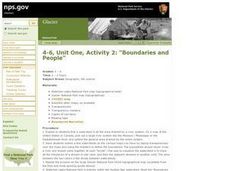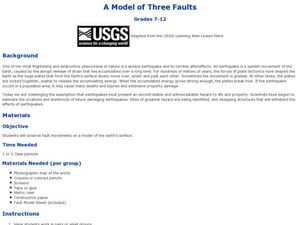Curated OER
Boundaries and People
Students map watersheds to find their boundaries. In this watershed activity students map and then give their "watershed address." Students show the trail from stream, larger stream to oceans. Students describe the...
Curated OER
Relationships for Students in Middle School
Boundaries are important in relationships, no matter how close the relationship is. Middle schoolers explore the ideas of boundaries and personal space with two units about relationships. After discussing the boundaries in their own...
Curated OER
The Blackfeet of Glacier National Park
Young scholars research an aspect of the Blackfeet tribe in Glacier National Park. They work together to create a presentation that is representative of their culture. They share their presentation with the class.
Curated OER
The League of Peace and Power-The Six Iroquois Nations and the American Revolution
Students examine primary sources concerning the members of the Iroquois nation in order to determine their reasons for signing a treaty with the new American government. They discover how this organization of Native American tribes...
Curated OER
Is A Nation Always A Region?
Students define the term, "nation," and analyze the boundaries established in Africa by colonial powers. In small groups, they participate in a simulated United Nations, develop a list of questions, analyze the nations of Africa, and...
Curated OER
The Cherokee: Trail Where They Cried
Learners read the Trail of Tears about the Cherokee Nation removal and write a letter pretending they are the grandparent of a Cherokee child. In this Trail of Tears lesson plan, students understand the changing of boundaries.
Curated OER
National Marine Sanctuaries Fish
Information is provided on Gray's Reef, Florida Keys, and Flower Garden Banks marine sanctuaries. Young marine biologists then visit the FishBase and REEF databases to collect fish species information for each location. They then...
Curated OER
Traditional Tribal Homelands of Washington's Plateau Nations
Students investigate the Plateau tribes. In this Native American lesson, students use a political map of Washington state to identify the location of the Plateau tribes. Students brainstorm the needs and wants of the tribes and use an...
Curated OER
Basic U.S. Geography
Provide your 11th graders with a basic understanding of U.S. Geography. They label the state, regions, and boundaries found in the contiguous U.S. as well as Hawaii and Alaska. Then, they complete two Internet related activities.
Curated OER
Boundary Crossing
Seventh graders explore the issues that arose as a result of boundary crossing. In this US History activity, 7th graders research supreme court cases in regards to crossing boundaries. Students present their findings to the...
Curated OER
Volcano!-Thar She Blows!
Students describe how volcanoes are formed. They name the types of boundaries where volcanoes occur. They utilize models to illustrate the occurence of volcanoes and earthquakes along plate boundaries. They compare and constrast the...
Curated OER
Boundaries
Students identify and analyze the boundaries which exist between urban and rural, wildness and country and among rural areas, country, town, and city. Students actively participate in planning, obtaining materials, setting goals and...
Curated OER
Symbols and Landmarks
Third graders study American national holidays, symbols, songs and landmarks. They appreciate the meaning and significance of our nation's ideals of liberty, justice and equality.
Curated OER
Book: Germany
Students, after reading Chapter One in the book, "Germany," analyze and recreate the political boundaries as well as the physical features of the nation of Germany with the assistance of play-doh or salt dough. In groups, they create...
National Park Service
What Can We Do?
Motivate young conservationists to stand up and make a change. After learning about the efforts in Cascade Nation Park to reduce carbon emissions in order to preserve the wilderness, young scholars work in groups creating action...
Curated OER
A Model of Three Faults
Students observe fault movements on model of the Earth's surface, find fault movements associated with different types of plate boundaries, research examples of non-plate boundary faults, and research and report on the types of faults...
US National Archives
Documented Rights Educational Lesson Plan
How have groups struggled to have their unalienable rights recognized in the United States? Acting as a research team for the Human Rights Council of the United Nations, your young historians will break into groups to research...
Foreign Policy Research Institute
Intro to China
Understanding the global interconnection between people of other nations is extremely important in our ever-shrinking world. Emergent global thinkers examine the significance of Chinese culture, religion, and political power. They then...
NOAA
Currents
Learn how ocean currents are vital to humans and marine life. The eighth installment of a 23-part NOAA Enrichment in Marine sciences and Oceanography (NEMO) program, focuses on ocean currents and how they affect global climate. The...
Curated OER
The Fault Line
Students use cardboard models of the North American and Pacific plates and sand to investigate what happens when there is an earthquake or movement along the boundaries of the plates.
Curated OER
South America Map
In this South American political map worksheet, students examine both national boundaries and national capitals.
Curated OER
Africa & Asia: Labeled Map
In this African and Asian political map learning exercise, students examine national boundaries and national capitals of the continents.
Curated OER
Europe Labeled Map
In this Europe political map worksheet, students examine the national boundaries. The map also highlights each of the nation's capitals with a star. The countries and capital cities in this map are labeled.
Curated OER
Central America Outline Map
In this Central American political map worksheet, learners make note of national boundaries and capitals in this region of the world. National capital city locations are noted with stars.

























